Italian actress Marina Berti (1924-2002) is a forgotten diva from the postwar Italian cinema. She was a popular starlet of Italian and Hollywood films in the 1940s and early 1950s – sometimes credited as Maureen Melrose.
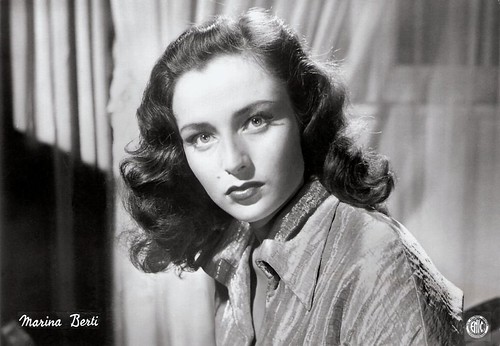
Italian postcard by Bromofoto, Milano (Milan), no. 981. Photo: ENIC.
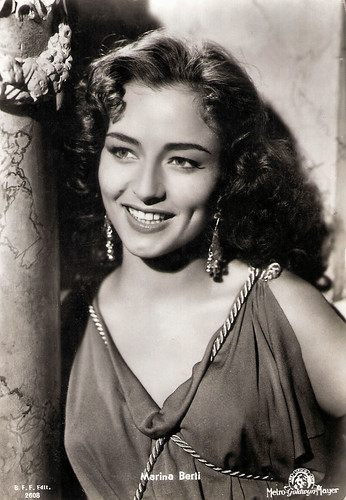
Italian postcard by B.F.F. Edit., no. 2608. Photo: Metro-Goldwyn-Mayer. Publicity still for Quo Vadis (Mervyn LeRoy, Anthony Mann, 1951).
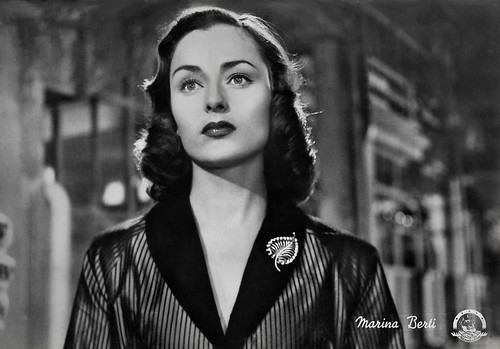
Italian postcard by Bromofoto, Milano, no. 471. Photo: Atlantic Film. Marina Berti in Febbre di vivere/Eager to Live (Claudio Gora, 1953). The film, Gora's second film as director after a rich career as an actor, was based on a play by Leopoldo Trieste called 'Cronaca'.
In 1924, Marina Berti was born Elena Maureen Bertolini in London, Great Britain, to Italian parents. She returned to Italy with her family in 1936. Her first, uncredited screen appearance was in the Anna Magnani film La Fuggitiva/The Fugitive (Piero Ballerini, 1941).
In 1942 Berti was the female lead in Giacomo l'idealista/Giacomo the Idealist (Alberto Lattuada, 1943), an early melodrama in which she starred opposite Massimo Serato. She had another success opposite Amedeo Nazzari in La donna della montagna/The Mountain Woman (Renato Castellani, 1943), before the Italian film industry collapsed in the later stages of the war.
La storia di una capinera/The History of a Sparrow (Gennaro Righelli, 1943), for instance, was shot in 1943 but not released until 1945. It was in this film she met actor Emilio Giordana, aka Claudio Gora, who she married the following year. Subsequently, they had three children who all went on to become actors, Andrea, Carlo, and Marina Giordana.
Her romantic interest in La porta del cielo/The Gate of Heaven (Vittorio De Sica, 1945) was handsome Massimo Girotti, and the following year the beautiful couple starred together again in Preludio d'amore/Love Prelude (Giovanno Paolucci, 1946) with Vittorio Gassman. 45 years later, they would be reunited in Dall'altra parte del mondo/From the Other Side of the World (Arnaldo Catinari, 1992).
Born in London, Berti's English skills enabled her to appear also in Hollywood productions shot in Cinecittà such as the historical adventure Prince of Foxes (Henry King, 1949) opposite Tyrone Power, the crime drama Deported (Robert Siodmak, 1950) with Märta Torén, and the historical epic Quo Vadis (Mervyn LeRoy, 1951) with Deborah Kerr.
She did appear in one film shot in America, the comedy Up Front (Alexander Hall, 1951), based on the popular wartime cartoons 'Lowbrow G.I.s Willie and Joe'. She didn’t endear herself to the Hollywood machine when she refused to appear in a skimpy bathing suit for PR photos, and her popularity never took off in the US.

Belgian card by Cine Metro, no. 1. Photo: Unitalia Films.
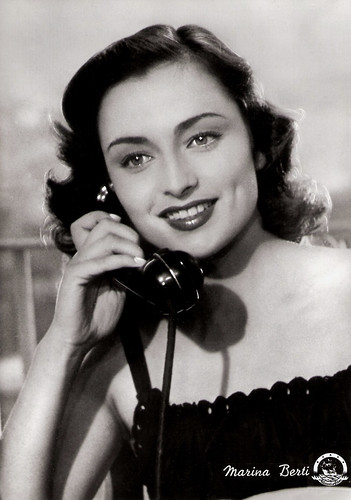
Italian postcard by Bromofoto, Milano (Milan), no. 384. Photo: Atlantisfilm.
During her career of more than sixty years, Marina Berti appeared in nearly 100 films and TV series. In the 1950s, the nature of her roles began to change, from being a girlish love interest in films like Il testimone/The Testimony (Pietro Germi, 1946) to more of a character actress.
Most of her Italian films in this period were no big successes and in the popular Hollywood epics Ben Hur (William Wyler, 1959) and Cleopatra (Joseph L. Mankiewicz, 1963), which were partly shot in Italy, she just had uncredited parts. Her part as the Queen of Tarsus in Cleopatra even ended on the cutting floor.
In the 1960s she played supporting parts in popular films like Madame Sans-Gêne (Christian-Jaque, 1962) starring Sophia Loren, and Made in Italy (Nanni Loy, 1965). Occasionally she was the leading lady, for instance in the war film Face in the Rain (Irvin Kershner, 1963) with Rory Calhoun.
She was very active in genre films such as the Peplum Il tiranno di Siracusa/The Tyrant of Syracuse (Curtis Bernhardt, 1962), the gothic horror Un angelo per Satana/An Angel for Satan (Camillo Mastrocinque, 1966) starring Barbara Steele, the Spaghetti Western Un uomo, un cavallo, una pistola/A Man, a Horse, a Gun (Luigi Vanzi, 1967), and the Giallos Qualcuno ha tradito/Every Man Is My Enemy (Franco Prosperi, 1967) with Robert Webber, and La polizia chiede aiuto/The Police Want Help (Massimo Dallamano, 1974) with Mario Adorf.
Her husband Claudio Gora directed her in three films, Il Cielo è rosso/The Sky Is Red (1950), Febbre di vivere/Eager to Live (1953), and the Spaghetti Western L’odio è il mio Dio/Hate Is My God (1969).
As the Italian film industry declined in the 1970s, she was more regularly found on television. She acted in such popular TV mini-series as L’Odissea/The Adventures of Ulysses (Franco Rossi, Mario Bava a.o., 1968), Moses the Lawgiver (Gianfranco De Bosio, 1974), Jesus of Nazareth (Franco Zeffirelli, 1977) and L’edera/The ivy (Fabrizio Costa, 1992).
Her later films include the drama La posta in gioco/The Stakes (Sergio Nasca, 1988) and Ostinato destino/Obstinate destiny (Gianfranco Albano, 1992) starring Monica Bellucci. Her last film appearance was a small part in the war drama Amen (Costa-Gavras, 2002).
Marina Berti died in 2002 in Rome, Italy, following an extended illness. She was 78. Her husband Claudio Gora had died in 1998.
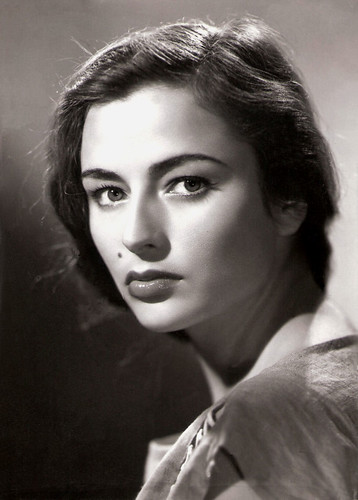
Italian photo card.
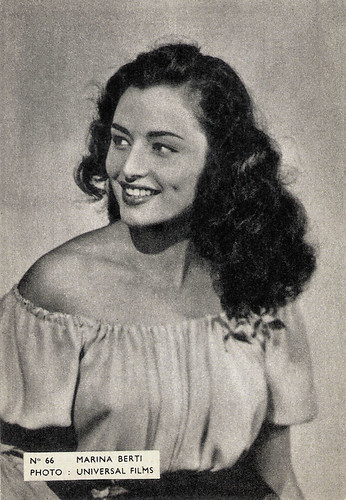
Belgian collectors card by Merbotex, Brussels for Ciné British Palace, Temse, no. 66. Photo: Universal Film. Publicity still for Up Front (Alexander Hall, 1951).

Spanish postcard by Archivo Bern, no. 7249, 1960-1961. Photo: MGM. Marina Berti and Charlton Heston in Ben-Hur (William Wyler, 1959).
Source: Matt Blake (The Wild Eye), Jason Buchanan (AllMovie), Glamour Girls of the Silver Screen, Wikipedia, and IMDb.
This post was last updated on 21 May 2021.

Italian postcard by Bromofoto, Milano (Milan), no. 981. Photo: ENIC.

Italian postcard by B.F.F. Edit., no. 2608. Photo: Metro-Goldwyn-Mayer. Publicity still for Quo Vadis (Mervyn LeRoy, Anthony Mann, 1951).

Italian postcard by Bromofoto, Milano, no. 471. Photo: Atlantic Film. Marina Berti in Febbre di vivere/Eager to Live (Claudio Gora, 1953). The film, Gora's second film as director after a rich career as an actor, was based on a play by Leopoldo Trieste called 'Cronaca'.
English Skills
In 1924, Marina Berti was born Elena Maureen Bertolini in London, Great Britain, to Italian parents. She returned to Italy with her family in 1936. Her first, uncredited screen appearance was in the Anna Magnani film La Fuggitiva/The Fugitive (Piero Ballerini, 1941).
In 1942 Berti was the female lead in Giacomo l'idealista/Giacomo the Idealist (Alberto Lattuada, 1943), an early melodrama in which she starred opposite Massimo Serato. She had another success opposite Amedeo Nazzari in La donna della montagna/The Mountain Woman (Renato Castellani, 1943), before the Italian film industry collapsed in the later stages of the war.
La storia di una capinera/The History of a Sparrow (Gennaro Righelli, 1943), for instance, was shot in 1943 but not released until 1945. It was in this film she met actor Emilio Giordana, aka Claudio Gora, who she married the following year. Subsequently, they had three children who all went on to become actors, Andrea, Carlo, and Marina Giordana.
Her romantic interest in La porta del cielo/The Gate of Heaven (Vittorio De Sica, 1945) was handsome Massimo Girotti, and the following year the beautiful couple starred together again in Preludio d'amore/Love Prelude (Giovanno Paolucci, 1946) with Vittorio Gassman. 45 years later, they would be reunited in Dall'altra parte del mondo/From the Other Side of the World (Arnaldo Catinari, 1992).
Born in London, Berti's English skills enabled her to appear also in Hollywood productions shot in Cinecittà such as the historical adventure Prince of Foxes (Henry King, 1949) opposite Tyrone Power, the crime drama Deported (Robert Siodmak, 1950) with Märta Torén, and the historical epic Quo Vadis (Mervyn LeRoy, 1951) with Deborah Kerr.
She did appear in one film shot in America, the comedy Up Front (Alexander Hall, 1951), based on the popular wartime cartoons 'Lowbrow G.I.s Willie and Joe'. She didn’t endear herself to the Hollywood machine when she refused to appear in a skimpy bathing suit for PR photos, and her popularity never took off in the US.

Belgian card by Cine Metro, no. 1. Photo: Unitalia Films.

Italian postcard by Bromofoto, Milano (Milan), no. 384. Photo: Atlantisfilm.
Amen
During her career of more than sixty years, Marina Berti appeared in nearly 100 films and TV series. In the 1950s, the nature of her roles began to change, from being a girlish love interest in films like Il testimone/The Testimony (Pietro Germi, 1946) to more of a character actress.
Most of her Italian films in this period were no big successes and in the popular Hollywood epics Ben Hur (William Wyler, 1959) and Cleopatra (Joseph L. Mankiewicz, 1963), which were partly shot in Italy, she just had uncredited parts. Her part as the Queen of Tarsus in Cleopatra even ended on the cutting floor.
In the 1960s she played supporting parts in popular films like Madame Sans-Gêne (Christian-Jaque, 1962) starring Sophia Loren, and Made in Italy (Nanni Loy, 1965). Occasionally she was the leading lady, for instance in the war film Face in the Rain (Irvin Kershner, 1963) with Rory Calhoun.
She was very active in genre films such as the Peplum Il tiranno di Siracusa/The Tyrant of Syracuse (Curtis Bernhardt, 1962), the gothic horror Un angelo per Satana/An Angel for Satan (Camillo Mastrocinque, 1966) starring Barbara Steele, the Spaghetti Western Un uomo, un cavallo, una pistola/A Man, a Horse, a Gun (Luigi Vanzi, 1967), and the Giallos Qualcuno ha tradito/Every Man Is My Enemy (Franco Prosperi, 1967) with Robert Webber, and La polizia chiede aiuto/The Police Want Help (Massimo Dallamano, 1974) with Mario Adorf.
Her husband Claudio Gora directed her in three films, Il Cielo è rosso/The Sky Is Red (1950), Febbre di vivere/Eager to Live (1953), and the Spaghetti Western L’odio è il mio Dio/Hate Is My God (1969).
As the Italian film industry declined in the 1970s, she was more regularly found on television. She acted in such popular TV mini-series as L’Odissea/The Adventures of Ulysses (Franco Rossi, Mario Bava a.o., 1968), Moses the Lawgiver (Gianfranco De Bosio, 1974), Jesus of Nazareth (Franco Zeffirelli, 1977) and L’edera/The ivy (Fabrizio Costa, 1992).
Her later films include the drama La posta in gioco/The Stakes (Sergio Nasca, 1988) and Ostinato destino/Obstinate destiny (Gianfranco Albano, 1992) starring Monica Bellucci. Her last film appearance was a small part in the war drama Amen (Costa-Gavras, 2002).
Marina Berti died in 2002 in Rome, Italy, following an extended illness. She was 78. Her husband Claudio Gora had died in 1998.

Italian photo card.

Belgian collectors card by Merbotex, Brussels for Ciné British Palace, Temse, no. 66. Photo: Universal Film. Publicity still for Up Front (Alexander Hall, 1951).

Spanish postcard by Archivo Bern, no. 7249, 1960-1961. Photo: MGM. Marina Berti and Charlton Heston in Ben-Hur (William Wyler, 1959).
Source: Matt Blake (The Wild Eye), Jason Buchanan (AllMovie), Glamour Girls of the Silver Screen, Wikipedia, and IMDb.
This post was last updated on 21 May 2021.
No comments:
Post a Comment